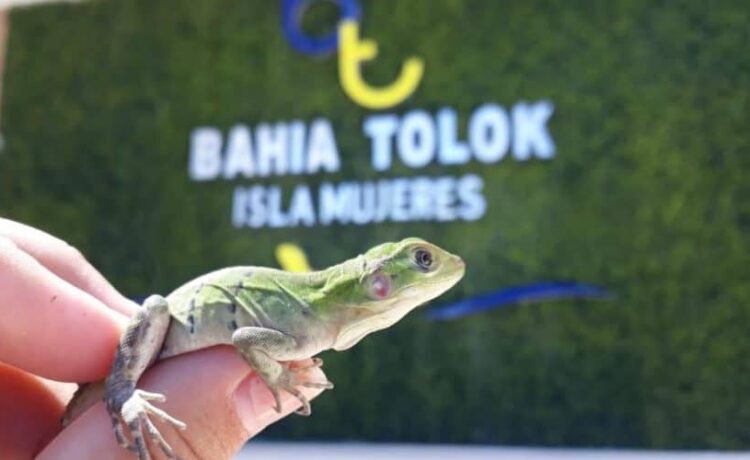The name «Tolok» originates from the local terms for male and female iguanas, with the male being called Tóol and the female Bílil. Although the Yucatán Peninsula is home to a diverse range of reptiles, only three species truly embody the essence of the Tolok: the Brown Basilisk (Basiliscus vittatus), the Green Lizard (Laemanctus longipes), and the Helmeted Lizard or Ya’axtolok (Laemanctus serratus).
In Yucatán, the term Tolok specifically refers to certain species of iguanas, such as the Black Iguana (Ctenosaura pectinata), the Striped Iguana (Ctenosaura similis), and the Spiny-tailed Iguana (Ctenosaura defensor).
At Bahía Tolok, we honor these majestic creatures by adopting their name, as they are an integral part of the natural beauty that surrounds Isla Mujeres. If you’re lucky, you might spot a Tolok basking in the sun along the seafront areas of our hotel or in other parts of the island, particularly near the southern tip.
These remarkable iguanas, often referred to as «dragons» or «living dinosaurs» due to their prehistoric appearance, are completely harmless. They tend to inhabit abandoned areas but occasionally grace us with their presence. So, while you relax at Bahía Tolok, keep an eye out for these ancient residents and enjoy the unique natural beauty they bring to Isla Mujeres.
Below are 9 interesting facts about this species:
Tolok can often be found in yards of homes or on vacant land
- The Tolok is accustomed to life on land, although some species live in water.
- They are oviparous (egg-laying).
- Their blood is cold, which is why they need to bask in the sun or stay in water to regulate their temperature.
- They don’t have pores in their skin, so they don’t sweat.
- Most species are carnivorous, but some are herbivores.
- Carnivores can take several days to digest their food.
- Some herbivores aid their digestion by eating stones.
- Many Tolok species can stay underwater for extended periods, thanks to their well-adapted lungs.
Tolok Behavior
Toloks are primarily solitary reptiles, preferring to establish their own territory rather than living in groups. They are highly territorial and will often defend their space from other reptiles, particularly during mating season. These creatures rely heavily on their environment for thermoregulation, spending a significant amount of time basking in the sun to maintain their body temperature.
In terms of communication, toloks use body language, such as head-bobbing, push-ups, and tail flicks, to signal dominance or attract mates. During confrontations, they may puff up their bodies and change color to appear more intimidating. Despite their somewhat aggressive territorial behavior, toloks are generally shy around humans, fleeing quickly if they feel threatened.
They are excellent climbers and often use vertical surfaces like rocks, trees, and even walls of buildings to escape predators or explore their surroundings. Their keen senses help them detect movement, allowing them to react swiftly to potential threats.
Diet and Feeding Habits of the Tolok
Toloks are omnivores, meaning their diet consists of both plant and animal matter, though their specific diet can vary depending on the species and habitat. In Isla Mujeres, toloks feed on a variety of local foods, adapting to their surroundings to find nourishment.
Typical Tolok Diet:
- Insects and Small Animals: Toloks primarily eat insects like crickets, beetles, ants, and grasshoppers. They may also consume small animals like lizards, and occasionally bird eggs if available.
- Fruits and Vegetation: Being opportunistic eaters, toloks also feed on fruits, flowers, and leaves found in their environment. Common fruits like papayas and figs, and even flowers from local plants, are part of their diet.
Toloks in Isla Mujeres: On Isla Mujeres, toloks make use of the island’s abundant vegetation and insect life. They are often seen hunting for insects in the more wooded areas or snacking on fruits fallen from trees. The local variety of toloks have adapted to this tropical environment, thriving on the mix of vegetation and smaller animals available.
In urban areas, toloks may also scavenge for scraps of food left by humans, though they primarily stick to their natural diet of plants and insects.
Conservation Status of Tolok in Isla Mujeres
The tolok species, particularly the Black Iguana (Ctenosaura pectinata) and the Spiny-tailed Iguana (Ctenosaura similis), are commonly found throughout Isla Mujeres. While these species are not currently considered endangered, they are subject to local environmental pressures that could affect their populations in the future.
Factors Affecting Their Conservation Status:
- Habitat Loss: Urban development and tourism expansion on Isla Mujeres have led to habitat loss for toloks. As more land is cleared for resorts, hotels, and infrastructure, the natural environments where toloks thrive are reduced.
- Human Interaction: Toloks often come into contact with humans, particularly in areas around hotels and residential zones. While they are generally harmless, increased interaction can sometimes lead to harm or displacement.
- Pollution: Littering and environmental pollution, particularly in urbanized parts of the island, can negatively impact the local wildlife, including toloks.
Conservation Efforts: While no specific programs are focused solely on tolok conservation, efforts to preserve the natural habitats of Isla Mujeres—such as protecting mangroves, coastal areas, and green spaces—indirectly help tolok populations thrive. Additionally, local awareness of the importance of these reptiles in maintaining ecological balance is growing.
Current Status: Toloks are classified as Least Concern on the IUCN Red List, but continued habitat preservation on Isla Mujeres is crucial to ensuring their populations remain stable in the long term.



